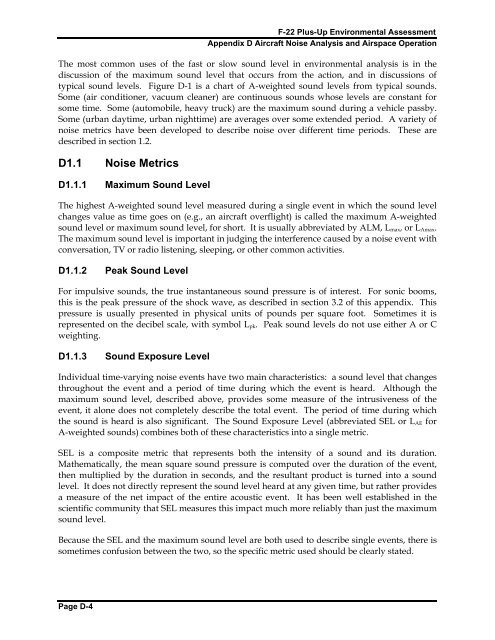F-22 Plus-Up Environmental Assessment - Joint Base Elmendorf ...
F-22 Plus-Up Environmental Assessment - Joint Base Elmendorf ...
F-22 Plus-Up Environmental Assessment - Joint Base Elmendorf ...
You also want an ePaper? Increase the reach of your titles
YUMPU automatically turns print PDFs into web optimized ePapers that Google loves.
F-<strong>22</strong> <strong>Plus</strong>-<strong>Up</strong> <strong>Environmental</strong> <strong>Assessment</strong><br />
Appendix D Aircraft Noise Analysis and Airspace Operation<br />
The most common uses of the fast or slow sound level in environmental analysis is in the<br />
discussion of the maximum sound level that occurs from the action, and in discussions of<br />
typical sound levels. Figure D-1 is a chart of A-weighted sound levels from typical sounds.<br />
Some (air conditioner, vacuum cleaner) are continuous sounds whose levels are constant for<br />
some time. Some (automobile, heavy truck) are the maximum sound during a vehicle passby.<br />
Some (urban daytime, urban nighttime) are averages over some extended period. A variety of<br />
noise metrics have been developed to describe noise over different time periods. These are<br />
described in section 1.2.<br />
D1.1 Noise Metrics<br />
D1.1.1<br />
Maximum Sound Level<br />
The highest A-weighted sound level measured during a single event in which the sound level<br />
changes value as time goes on (e.g., an aircraft overflight) is called the maximum A-weighted<br />
sound level or maximum sound level, for short. It is usually abbreviated by ALM, L max , or L Amax .<br />
The maximum sound level is important in judging the interference caused by a noise event with<br />
conversation, TV or radio listening, sleeping, or other common activities.<br />
D1.1.2<br />
Peak Sound Level<br />
For impulsive sounds, the true instantaneous sound pressure is of interest. For sonic booms,<br />
this is the peak pressure of the shock wave, as described in section 3.2 of this appendix. This<br />
pressure is usually presented in physical units of pounds per square foot. Sometimes it is<br />
represented on the decibel scale, with symbol L pk . Peak sound levels do not use either A or C<br />
weighting.<br />
D1.1.3<br />
Sound Exposure Level<br />
Individual time-varying noise events have two main characteristics: a sound level that changes<br />
throughout the event and a period of time during which the event is heard. Although the<br />
maximum sound level, described above, provides some measure of the intrusiveness of the<br />
event, it alone does not completely describe the total event. The period of time during which<br />
the sound is heard is also significant. The Sound Exposure Level (abbreviated SEL or L AE for<br />
A-weighted sounds) combines both of these characteristics into a single metric.<br />
SEL is a composite metric that represents both the intensity of a sound and its duration.<br />
Mathematically, the mean square sound pressure is computed over the duration of the event,<br />
then multiplied by the duration in seconds, and the resultant product is turned into a sound<br />
level. It does not directly represent the sound level heard at any given time, but rather provides<br />
a measure of the net impact of the entire acoustic event. It has been well established in the<br />
scientific community that SEL measures this impact much more reliably than just the maximum<br />
sound level.<br />
Because the SEL and the maximum sound level are both used to describe single events, there is<br />
sometimes confusion between the two, so the specific metric used should be clearly stated.<br />
Page D-4
















